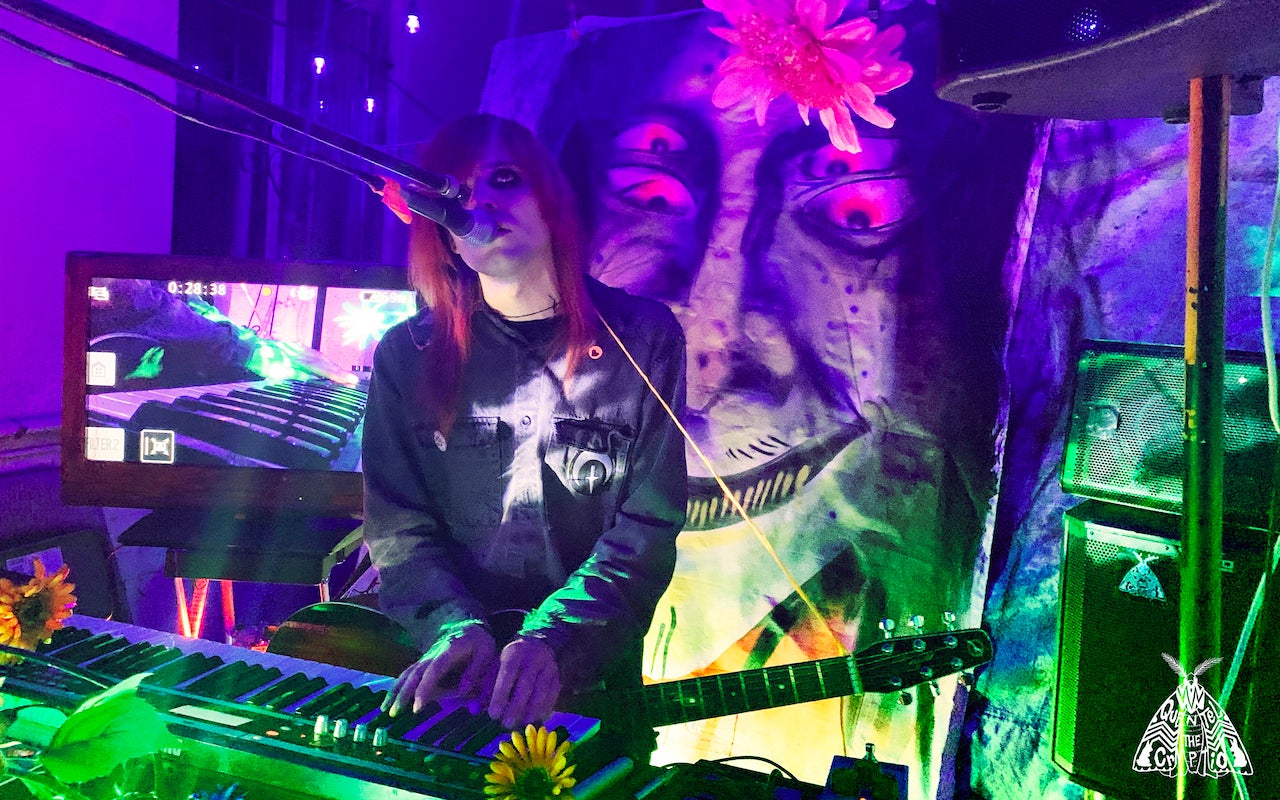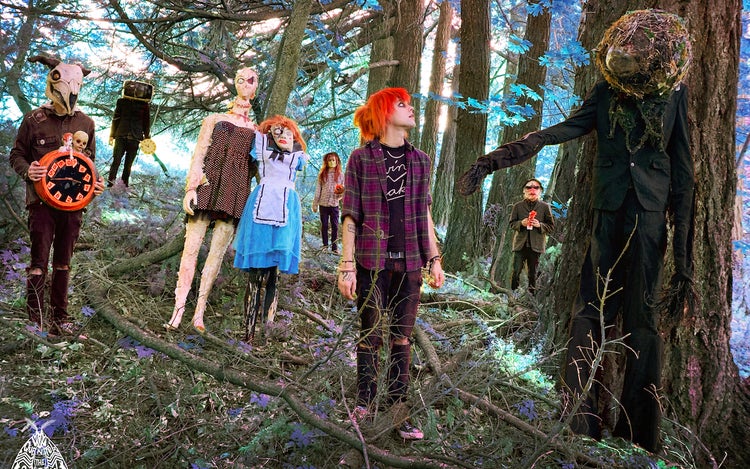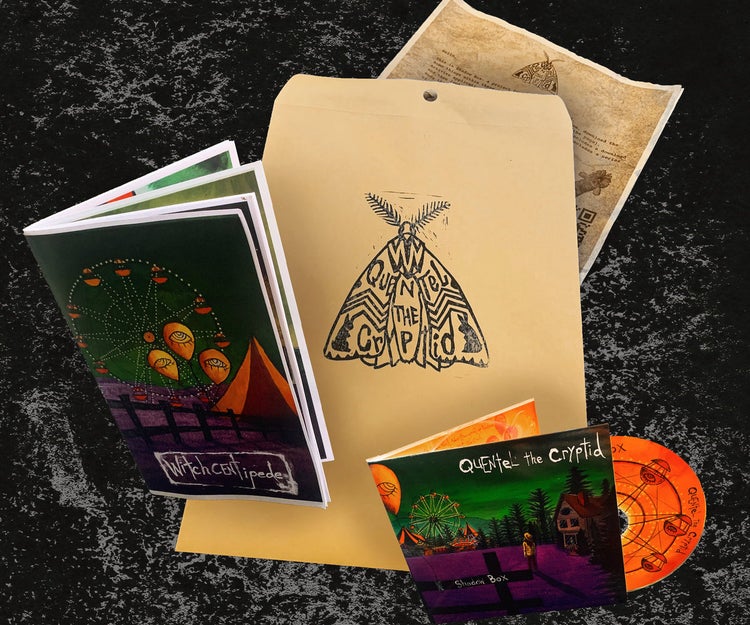“Do you have a secret?” – An interview with Quentel the Cryptid’s Sean M.
 By Sasha
By Sasha

I don’t know how to set the scene for you. Let’s try this: imagine you are standing on a wide, graded, rust-brown dirt path. It snakes along through steep hills that look crumpled from a distance, but, here among them, they are towering. Thatched in dead grasses, they glow a tarnished gold under robin’s egg skies. The seams of the canyons run wild with dusty trees, clinging to the steep slopes.
There is a lone, majestic oak perched high on the hill before you. Under its gnarled, wind-tossed branches stands Quentel the Cryptid, black shadow sinking their eyes, chin-length red-orange hair framing their narrow face. They are strumming an acoustic guitar, singing to the hills, which you now notice are alive with roaming oddities.
What you first mistake for a scarecrow is a lost eccentric with long, bright red hair, wearing an impassive porcelain mask, broad-brimmed straw hat, and faded flannel shirt. There is also a tall black-clad figure, who, impossibly, has a bull’s skull for a head. Crowned in twisted horns, he marches forward carrying a clock with its numbers out of order and its hands racing timeless. You instinctively know their names to be Winchester and The Wanderer. It is a mystery to you why or even how they are here, and yet they are.
I am doing my best to describe to you the opening moments of the music video for “Ghost Trap,” one of the two singles off Shadow Box, the second full-length from Sean M.’s decade-old solo project Quentel the Cryptid. This brief sequence illustrates just a few traits of a truly idiosyncratic artist who has found a home in the Bay Area. Sean’s music is supported by an enigmatic personal mythos, a parallel art practice, an unbridled DIY ethos, and a range of creative collaborators.
I spoke to Sean in mid-January over the phone while they were home in Concord. They had recently self-released Shadow Box near the close of 2020, marking the end of the year-and-a-half-long project. “Songwriting, for me,” says Sean, “always starts with chords and melody, usually on guitar. And that kind of happens before anything else. Then, I usually start working with the rhythm section, using some drum machines with bass guitar, stuff like that, and then build up the song from there.” For Shadow Box, this included the addition of field recordings captured in Contra Loma Regional Park in Antioch (also the shoot location of much of the “Ghost Trap” video).
The lyrics of Sean’s songs are deeply personal. “It's usually at the end [of the songwriting process] that I actually sit down and write words. I'll make stuff up as I go. I don't think too much about it. I just kind of sing and whatever kind of happens is what I go with. The lyrics are just kind of about whatever's going on. It's a means of, you know, dealing with things or even just, I guess, exploring the thoughts that I'm having.”
Shadow Box features nine expansive songs that rise from melancholy atmospheric washes. Driven largely by Sean’s electrified acoustic guitar and drums by Vantana Row’s Jamey Blaze, the tracks tremble with a cathartic push-pull between darkness and light. Haunting melodic hooks on synth and piano emerge to the foreground during the bridges to give a sense of urgent drama, often gathering into stirring crescendos.
The LP was predominantly written and recorded during the SARS-CoV-2 pandemic. Sean says that the regional lockdowns gave them more time to work on this album. “I think a lot of times I'm inclined to rush. I put a lot of pressure on myself to work quickly, and sometimes don't give enough attention. In retrospect, I'll realize maybe I should have spent more time on something.”
In March 2020, Sean was getting ready to perform a series of shows locally and in the Pacific Northwest. “I was going to start focusing on how I was going to play the songs live and different things I could do with them. And then, when that didn't happen, there was a lot of time to reevaluate where the songs were. That extra time allowed for the songs to go in a different direction.”
This included working with Jamey, an opportunity that may not have been open had public health precautions not shutdown live performances indefinitely. “Having people to collaborate with is enormous. Sometimes that's really easy to overlook when you're working as a solo artist, because you start to think about carrying all the responsibility all the time. A lot of times, it's better if you get other people involved, because other people have different perspectives and different strengths that you probably don't have. Working with Jamey and getting somebody else to play drums, I got somebody else's interpretation of the rhythm section, and just saw how much that transformed the songs.”

Quentel the Cryptid is much more than Sean’s music. Each album, poster, video, live show prop or costume is laced in a visual vocabulary of arcane fantasy that is both playful and monstrous. This is the WitchCentipede universe, which is populated by an ever expanding constellation of impenetrable characters like Winchester and The Wanderer. They inhabit a gloomy funhouse dimension that is populated by giant friendly black widow spiders, fanged fiends with flowers for eyes, and living mannequins with damaged faces and bright blue dresses. There is a connective narrative that lives mostly in Sean’s dreams and notebooks, but they are cryptically short on details: “I don’t want to give too much away, because that’s part of the allure, at least for me. The stuff that keeps it interesting is that there is some mystery to it.”
Around the time Sean moved from Pennsylvania to California in 2016, they met artist Elly Russell. Together, they started a parallel art practice based on Sean’s characters, which they called WitchCentipede. “I like to say that Quentel the Cryptid and WitchCentipede are separate, but they're probably not. For both, I kind of operate on the same style of working. I mean, there's not a lot of conscious decisions being made. WitchCentipede’s stream of consciousness, it's reactive, and the way that it interplays with the music is similar. As I'm working on songs, I'm sending stuff to Elly and Elly is coming up with ideas (and I'm also coming up with visual ideas). And so it's all kind of happening simultaneously. I have said in the past that they're separate, because, for a while, some people thought that I was writing songs about the characters, and that wasn't so much happening, which would be interesting, I have nothing against that, but that's just not what I was doing. But I do think WitchCentipede is an extension of whatever is going on musically.”

Calling it an extension is an understatement, which Sean is prone to do as we discuss their work. WitchCentipede is galactic in scope, and the resulting creative output is an inescapable supermassive blackhole for attention (a welcome distraction in these unending days of lockdowns, quarantines, and social distance). Shadow Box is a perfect encapsulation of Sean and Elly’s ambition and work ethic. Each song on the album is accompanied by a full-color illustration by Elly, who also designed the album’s cover. If you order the CD, it comes with additional artwork in the form of a zine that has AR elements embedded into the pages, which you can activate with a smartphone or tablet. Elly handmade dozens of puppets, which Sean filmed in the video for the single “Blue Flowers” (BFF.fm premiered the video last week). The other video – “Ghost Trap” – was filmed over eight months and then rotoscoped, which means Elly digitally manipulated every single frame of the video, thousands of frames. Sean and Elly also collaborate on the posters, videos, props, and costumes for Sean’s immersive live shows, which, for the time being, can be found online, mostly on Instagram at @quentelthecryptid. There’s even an hour-long making-of documentary about the album called Memory Loss. Or, as Sean put it, with a chuckle, “Yeah, there’s a lot. We don’t stop. We keep going.”

When I asked Sean how they can keep up this inspiring (and intimidating) pace, they replied, “I can look back a few years and I wasn't nearly as productive. And I think some of that is discipline. And some of that is having accountability. That sounds, really, like it's a job. And, I mean, Elly and I do kind of treat it that way. But it doesn't ever feel that way. We do it because we love doing it. And because there's always ideas. I feel very fortunate to work with someone like Elly, who is able to realize the side of things that I don't have the skill sets to, like all the illustration and the animation. It’s been really important to have someone who can actually make the characters in a way that looks something more like what I had imagined. And, I don't know, it’s just great to get to work really closely with someone who has a similar investment in what you're doing and to be able to constantly bounce ideas off each other.”
Shadow Box was only just released a month ago, but Sean and Elly have already started a new project. “As it stands now, I've got, like, some new songs that I'm arranging, and Elly's started working on some new visual stuff. We have a rough idea what we might do. I always think in terms of albums, even though we live in a time when it's difficult to keep people's attention spans, especially when you're making this stuff that has a long through line and you're asking for people to invest an amount of time so you can communicate what you're trying to do. I'll still make an album, but make it so that each song can be a single, and we'll make a video for every single song. Elly and I have only spoken about the 10-video idea once, but I think we might do that. We'll see. It seems like every time we start something, we try to outdo the last time.”
Shadow Box is available on Bandcamp, Spotify, Apple Music, and at the Puzzle Box Facility.
